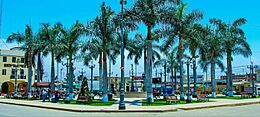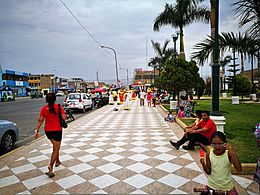Chincha Alta facts for kids
Quick facts for kids
Chincha Alta
|
|||
|---|---|---|---|
|
Town
|
|||
|
|||
| Nickname(s):
"Cuna de campeones" (Cradle of Champions)
|
|||
| Country | |||
| Region | Ica | ||
| Province | Chincha | ||
| Area | |||
| • Total | 2,988 km2 (1,154 sq mi) | ||
| Elevation | 97 m (318 ft) | ||
| Population | |||
| • Estimate
(2015)
|
177,219 | ||
| Demonym(s) | Chinchano/a | ||
| Time zone | UTC-5 (PET) | ||
| • Summer (DST) | UTC-5 (PET) | ||
| Website | www.munichincha.gob.pe | ||
Chincha Alta is a lively city in Peru. It is found in the Ica Region. This city is an important port near the Chincha River. It is also the main city of Chincha Province. About 233,000 people live here. This makes it one of the biggest cities in Peru.
Contents
Geography of Chincha Alta
The city of Chincha Alta is located about 200 kilometers south of Lima. It is part of the Chincha Province in the Ica Region of Peru. The city covers an area of 2988 square kilometers.
History of Chincha Alta
Early People: Pre-Chincha Era
The very first people arrived in this area around the 800s. We call them the "Pre-Chincha" people. A historian named Luis Cánepa Pachas thinks they came in the 900s. These early people mostly fished and gathered shells for food. We are still learning about where the Pre-Chincha people came from.
The Chincha People Arrive
In the 1000s, a new group came to the coast. They were called the Chincha. They were more advanced and known for being strong. The Chincha built buildings, grew crops, and had ways to bring water to their farms. They became the main group in the area. The Chincha learned some things from the Pre-Chincha people.
The word "Chincha" comes from words like "Chinchay" or "Cinca." These words mean "ocelot" in the Quechua language spoken by the Chincha. The Chincha people believed they came from ocelots. They thought this made them brave and strong. They also learned to use dead birds and guano (bird droppings) to make their fields fertile. This knowledge was passed down. The Chincha also became skilled sailors. They may have even traveled as far as Central America by boat.
Chincha and the Inca Empire
Between 1458 and 1460, the Chincha people were taken over by the Inca Empire. This happened during the rule of Emperor Pachacuti. His son, Tupac Inca Yupanqui, led the Inca army. The Chincha area became an important part of the Inca Empire. The Inca leaders valued the Chincha for their farming skills, their strong army, and their trade routes.
Chincha During Colonial Times
Later, the Spanish arrived and took control of the Chincha region. During the first 85 years of Spanish rule, the number of people living there dropped a lot. Many areas became wild again. People from Africa were brought to the region by the Spanish. Some of these people found safe places in the areas around Chincha.
Modern Chincha
In the early 1800s, British sailors knew Chincha as "Chinca" or "Chinka." In 1806, two British ships, Port au Prince and Lucy, captured some Spanish ships near the coast. They also had some battles with a Spanish ship called Astraea.
The Chincha Islands are off the coast of Peru, near Chincha and Pisco. These islands were important during the Chincha Islands War. This war was fought between Peru and Spain from 1864 to 1866.
The 2007 Earthquake
In 2007, a strong earthquake hit the Pacific coast of Peru. Chincha Alta was one of the cities that was damaged by this earthquake.
Culture in Chincha Alta
African Art and Music
Afro-Peruvian culture is very strong in Chincha Alta. The people of African heritage in the El Carmen district enjoy many traditional dances. Music plays a big part in Afro-Peruvian culture. Instruments like the Cajón drum and maracas are very important. This music is popular all over the region. Special traditional dances are performed during the Christmas season.
Afro-Peruvian Folk Culture
Every February, Chincha Alta holds a festival called "Verano Negro." This means "Black Summer." It celebrates Afro-Peruvian food, music, culture, and dance. The food in the Chincha Alta area is special. It has unique flavors because of its African background.
Climate of Chincha Alta
| Climate data for Chincha Alta, elevation 71 m (233 ft), (1991–2020) | |||||||||||||
|---|---|---|---|---|---|---|---|---|---|---|---|---|---|
| Month | Jan | Feb | Mar | Apr | May | Jun | Jul | Aug | Sep | Oct | Nov | Dec | Year |
| Mean daily maximum °C (°F) | 27.4 (81.3) |
28.5 (83.3) |
28.1 (82.6) |
26.5 (79.7) |
23.6 (74.5) |
21.2 (70.2) |
20.2 (68.4) |
19.8 (67.6) |
20.7 (69.3) |
21.6 (70.9) |
23.1 (73.6) |
25.2 (77.4) |
23.8 (74.9) |
| Mean daily minimum °C (°F) | 19.9 (67.8) |
20.6 (69.1) |
20.1 (68.2) |
18.0 (64.4) |
15.7 (60.3) |
14.7 (58.5) |
14.4 (57.9) |
14.4 (57.9) |
14.6 (58.3) |
14.9 (58.8) |
15.7 (60.3) |
17.7 (63.9) |
16.7 (62.1) |
| Average precipitation mm (inches) | 0.6 (0.02) |
0.8 (0.03) |
0.6 (0.02) |
0 (0) |
0.3 (0.01) |
1.1 (0.04) |
1.6 (0.06) |
1.1 (0.04) |
1.0 (0.04) |
0.6 (0.02) |
0.3 (0.01) |
0.4 (0.02) |
8.4 (0.31) |
| Source: National Meteorology and Hydrology Service of Peru | |||||||||||||
Chincha Alta Anthem
The anthem of Chincha Alta was created in 1984. Mrs. Ana Maria del Solar wrote the music. Manolo Andrade Avalos wrote the words. It was officially approved on October 30 of that year. The anthem has a chorus and three verses. It praises the beauty of the Chincha region. It also celebrates the bravery of its people.
See also
 In Spanish: Chincha Alta para niños
In Spanish: Chincha Alta para niños













